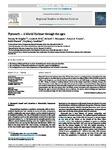Plymouth: A World Harbour through the ages
| dc.contributor.author | Knights, Antony | |
| dc.contributor.author | Firth, Louise | |
| dc.contributor.author | Yunnie, A | |
| dc.contributor.author | Thompson, Richard | |
| dc.contributor.author | Hiscock, K | |
| dc.contributor.author | Hawkins, SJ | |
| dc.date.accessioned | 2016-02-29T09:21:24Z | |
| dc.date.available | 2016-02-29T09:21:24Z | |
| dc.date.issued | 2016-11-01 | |
| dc.identifier.issn | 2352-4855 | |
| dc.identifier.issn | 2352-4855 | |
| dc.identifier.uri | http://hdl.handle.net/10026.1/4368 | |
| dc.description.abstract |
Plymouth Sound and adjacent estuaries, UK has been used as a working harbour throughout the ages and has a place in maritime history as the port from where the Pilgrim Fathers left for North America in 1620 on the Mayflower and Charles Darwin departed from on the HMS Beagle on his trip to Galapagos in 1831. Today, it remains a working harbour, home to the largest naval base in Western Europe, the host of numerous cruise ships and recreational boats, yet its complex of estuaries (Tamar, Plym, Lynher) and creeks is nationally and internationally recognised as of conservation importance due to its physical characteristics and flora and fauna. Here, we briefly recount the history and importance of Plymouth through the ages in terms of its historic use as a harbour, its marine science heritage and importance on the international stage. We also briefly describe its ecology. | |
| dc.format.extent | 297-307 | |
| dc.language | English | |
| dc.language.iso | English | |
| dc.publisher | Elsevier | |
| dc.subject | Plymouth Sound | |
| dc.subject | Special Area of Conservation | |
| dc.subject | World Harbour Project | |
| dc.subject | Biodiversity | |
| dc.title | Plymouth: A World Harbour through the ages | |
| dc.type | journal-article | |
| dc.type | Article | |
| plymouth.author-url | http://www.sciencedirect.com/science/article/pii/S2352485516300160 | |
| plymouth.volume | 8 | |
| plymouth.publication-status | Published | |
| plymouth.journal | Regional Studies in Marine Science | |
| dc.identifier.doi | 10.1016/j.rsma.2016.02.002 | |
| plymouth.organisational-group | /Plymouth | |
| plymouth.organisational-group | /Plymouth/Faculty of Science and Engineering | |
| plymouth.organisational-group | /Plymouth/Faculty of Science and Engineering/School of Biological and Marine Sciences | |
| plymouth.organisational-group | /Plymouth/REF 2021 Researchers by UoA | |
| plymouth.organisational-group | /Plymouth/REF 2021 Researchers by UoA/UoA07 Earth Systems and Environmental Sciences | |
| plymouth.organisational-group | /Plymouth/Research Groups | |
| plymouth.organisational-group | /Plymouth/Research Groups/Marine Institute | |
| plymouth.organisational-group | /Plymouth/Users by role | |
| plymouth.organisational-group | /Plymouth/Users by role/Academics | |
| plymouth.organisational-group | /Plymouth/Users by role/Researchers in ResearchFish submission | |
| dcterms.dateAccepted | 2016-02-03 | |
| dc.rights.embargodate | 2017-2-12 | |
| dc.identifier.eissn | 2352-4855 | |
| dc.rights.embargoperiod | Not known | |
| rioxxterms.versionofrecord | 10.1016/j.rsma.2016.02.002 | |
| rioxxterms.licenseref.uri | http://www.rioxx.net/licenses/all-rights-reserved | |
| rioxxterms.licenseref.startdate | 2016-11-01 | |
| rioxxterms.type | Journal Article/Review |


